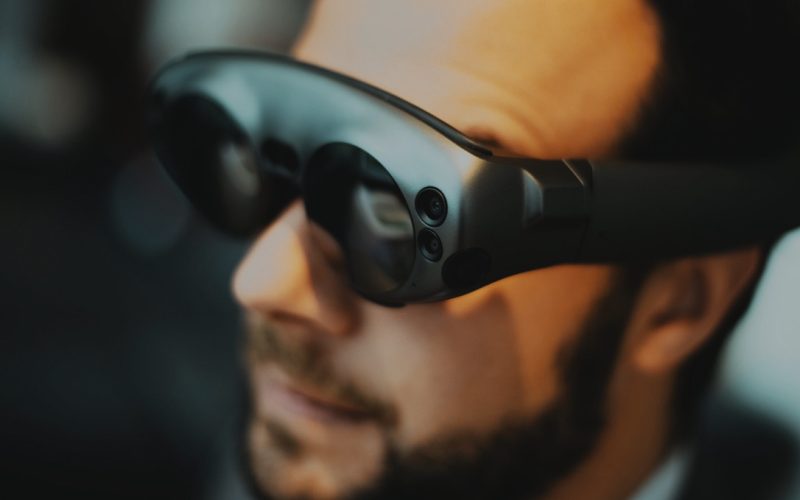Table of Contents Show
I. Understanding Augmented Reality: The Basics and Beyond
Augmented Reality (AR) has rapidly transitioned from science fiction to a part of our everyday lives, subtly yet powerfully altering how we interact with the world. Unlike Virtual Reality (VR), which immerses users in a fully digital environment, AR overlays digital information onto the physical world, enhancing our perception of reality. Imagine walking down the street and seeing digital information about a restaurant floating beside its entrance or using your phone’s camera to visualize how a piece of furniture would look in your living room before buying it. This is the power of AR.
The technology behind AR is as fascinating as its applications. At its core, AR uses a combination of sensors, cameras, and computer vision to recognize the physical world and superimpose digital elements onto it. These digital elements can be anything from text and images to complex 3D models and animations. The experience is rendered in real-time, allowing users to interact with the augmented world seamlessly. Devices like smartphones, tablets, and specialized AR glasses serve as the interface through which users access this augmented layer of reality.
AR has been around in some form for decades, with early iterations appearing in military and industrial applications. However, it wasn’t until the advent of smartphones with powerful processors and high-quality cameras that AR began to reach a broader audience. One of the most significant milestones in AR’s mainstream adoption was the release of Pokémon Go in 2016, a mobile game that used AR to bring digital creatures into the real world. Since then, AR has evolved into a versatile tool with applications that extend far beyond gaming.
Despite its rapid growth, AR is still in its early stages, with much of its potential yet to be realized. The technology is evolving quickly, with advances in hardware and software making AR experiences more immersive, accurate, and accessible. As AR continues to develop, it is poised to become a fundamental part of how we interact with information and the world around us. But to fully grasp the impact of AR, it’s essential to explore its current applications across various industries and understand how it’s already changing the way we live, work, and play.
II. The Current Applications of AR: From Entertainment to Industry
AR has found its way into numerous sectors, revolutionizing everything from entertainment and education to retail and healthcare. To understand the breadth of AR’s impact, let’s explore how it is being used in some of these key areas.
Entertainment and Gaming: The entertainment industry has been one of the earliest and most enthusiastic adopters of AR. Games like Pokémon Go and Ingress have shown how AR can create immersive experiences that blend the digital and physical worlds. But AR’s influence in entertainment extends beyond gaming. Augmented reality filters on social media platforms like Snapchat and Instagram allow users to alter their appearance or surroundings in creative and playful ways. Concerts and live events are also experimenting with AR to enhance the audience experience, offering digital overlays that provide additional content, like lyrics, information about the performers, or even interactive elements.
Retail and E-commerce: AR is transforming the retail experience by bridging the gap between online and in-store shopping. Brands like IKEA and Sephora have developed AR apps that allow customers to visualize products in their own environment before making a purchase. With IKEA’s AR app, you can see how a couch will look in your living room or how a painting will fit on your wall. Sephora’s app lets you try on makeup virtually, testing different shades and styles without the need for physical samples. This “try before you buy” approach not only enhances the shopping experience but also reduces returns and increases customer satisfaction.
Education and Training: AR is proving to be a powerful tool for education and training, offering immersive experiences that make learning more engaging and effective. In classrooms, AR can bring lessons to life by allowing students to interact with 3D models and simulations. Imagine studying the solar system and being able to explore the planets in 3D, or learning about the human body by examining an interactive model that shows how organs function. In professional training, AR is being used to provide hands-on experience in a safe and controlled environment. For example, medical students can practice surgeries using AR simulations, while engineers can train on complex machinery without the need for physical equipment.
Healthcare: AR is making significant strides in healthcare, where it is being used to improve diagnostics, treatment, and patient care. Surgeons are using AR to enhance precision during operations, overlaying digital images onto the patient to guide their work. This can help in locating tumors, identifying blood vessels, and avoiding critical structures. AR is also being used in medical imaging, allowing doctors to visualize complex anatomy in 3D, which can improve diagnosis and treatment planning. In patient care, AR applications are being developed to assist with rehabilitation, mental health treatment, and even patient education, helping individuals better understand their conditions and treatment options.
These examples highlight the versatility and potential of AR across various sectors. However, as AR continues to integrate into our lives, it raises important questions about privacy, security, and the broader societal implications of a world where the line between physical and digital is increasingly blurred.
III. The Challenges and Controversies: Privacy, Security, and Ethical Considerations
As AR becomes more prevalent, it brings with it a host of challenges and controversies that need to be addressed. While the technology offers incredible possibilities, it also raises significant concerns, particularly around privacy, security, and the ethical implications of augmenting reality.
Privacy Concerns: One of the most pressing issues with AR is privacy. AR applications often rely on collecting and processing large amounts of data from users, including location, facial features, and interactions with the physical environment. This data can be incredibly valuable for companies, but it also poses risks if not handled properly. There are concerns that AR could lead to increased surveillance, with companies and governments using the technology to track individuals’ movements and behaviors. Additionally, the use of facial recognition in AR could lead to invasions of privacy, as people could be identified and tracked without their knowledge or consent.
Security Risks: The integration of AR into everyday life also raises security concerns. As AR devices become more connected, they could become targets for hackers looking to exploit vulnerabilities in the system. For example, an AR app that overlays navigation information onto the real world could be hacked to provide false directions, leading to potentially dangerous situations. Moreover, as AR is used in critical sectors like healthcare and transportation, the stakes are even higher, with security breaches potentially leading to life-threatening consequences. Ensuring the security of AR systems will be crucial as the technology continues to evolve.
Ethical Implications: Beyond privacy and security, there are broader ethical considerations surrounding AR. One concern is the potential for AR to create or reinforce social divisions. As AR becomes more integrated into our lives, those who have access to the technology may gain significant advantages over those who do not, exacerbating existing inequalities. There are also concerns about the impact of AR on our perception of reality. As the line between the physical and digital worlds becomes increasingly blurred, there is a risk that people could become disconnected from the real world, relying too heavily on augmented experiences.
Manipulation and Misinformation: AR also has the potential to be used for manipulation and the spread of misinformation. As AR content becomes more realistic and immersive, it could be used to deceive people, presenting false information as if it were real. This could be particularly dangerous in areas like news and politics, where AR could be used to create convincing but entirely fabricated scenarios. The ability to manipulate reality in this way raises serious ethical questions about the use of AR and the responsibilities of those who develop and deploy the technology.
These challenges highlight the need for careful consideration and regulation as AR continues to develop. While the technology offers immense possibilities, it is essential to address these issues to ensure that AR is used in ways that are ethical, secure, and respectful of privacy.
IV. The Future of AR: What Lies Ahead
As we look to the future, it’s clear that AR is poised to become an integral part of our lives, transforming how we interact with the world and each other. The technology is still in its early stages, but the pace of innovation is accelerating, and the possibilities are vast.
Advances in Hardware: One of the key drivers of AR’s future development will be advances in hardware. As devices become more powerful, lightweight, and affordable, AR experiences will become more immersive and accessible. The development of AR glasses, in particular, could be a game-changer, allowing users to interact with augmented reality without the need for a smartphone or tablet. Companies like Apple, Google, and Facebook are already investing heavily in AR hardware, and we can expect to see significant advancements in the coming years.
Integration with AI: Another major trend in the future of AR is its integration with artificial intelligence (AI). AI can enhance AR experiences by making them more personalized, adaptive, and intelligent. For example, AI algorithms can analyze a user’s environment and behavior to provide more relevant and context-aware AR content. In education, AI-powered AR could offer personalized learning experiences tailored to each student’s needs and preferences. In healthcare, AI could work alongside AR to provide real-time analysis and recommendations during surgeries or medical consultations.
Expansion into New Sectors: As AR technology continues to develop, it is likely to expand into new sectors, creating opportunities for innovation and disruption. For example, AR could play a significant role in the future of work, enabling remote collaboration and virtual meetings that feel as immersive as being in the same room. In real estate, AR could revolutionize the way we buy and sell property, allowing potential buyers to take virtual tours of homes from anywhere in the world. In tourism, AR could enhance travel experiences by providing interactive guides and augmented information about historical sites and landmarks.
Social and Cultural Impact: The widespread adoption of AR will also have a profound impact on society and culture. As AR becomes more integrated into our daily lives, it will change how we interact with information, with each other, and with the world around us. AR has the potential to make our lives more convenient, connected, and informed, but it also raises important questions about the nature of reality, identity, and human connection. How we choose to use and regulate AR will shape its impact on society, and it will be crucial to ensure that the technology is developed and deployed in ways that benefit everyone.
In conclusion, augmented reality is a transformative technology with the potential to revolutionize numerous aspects of our lives. While it offers exciting possibilities, it also presents significant challenges that must be addressed. As AR continues to evolve, it will be essential to navigate these challenges carefully, ensuring that the technology is used to create a better, more connected, and more equitable world.








